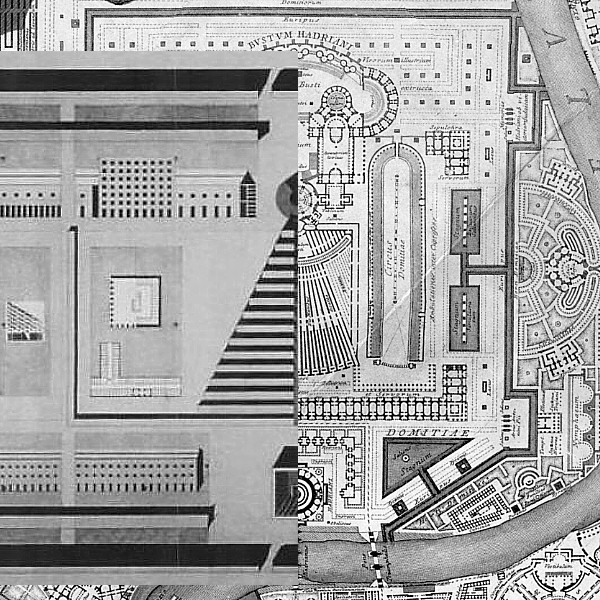Vincenzo Fasolo, "The Campo Marzio of G. B. Piranesi".
2691d
1956
The complex of buildings...
1982.03.01

"The complex of buildings in the center of Rossi's cemetery, however, is not found in the 19th century cemeteries of the Modena/Genoa type. That idea came from another source, Giovanii Battista Piranesi's reconstruction of the Campo Marzio in Rome, as he imagined it stood in late imperial times. In Piranesi's map, a large portion of the right bank of the Tiber is occupied by a group of funerary monuments dominated by the mausoleum of Hadrian, which we now know as Castel Sant'Angelo. Hadrian's tomb sits on a square base near the river. Beyond this square is a U-shaped group of buildings marked Sepulchra. They embrace the bottom of a fan-shaped structure designated by the word clitoporticus. At the apex of the fan sits a round building called Basilica. This Basilica is part of a group of monuments labeled Bustum Hadriani, designating the place where cremation occurs. The correspondence in general layout between the Piranesi and Rossi plans is too close to be accidental. Rossi, who knew this Piranesi work perfectly well (a fragment of it appears in Rossi's drawing The Analogous City, 1976), has lifted Piranesi's vision of an Imperial ancient city of the dead within the context of late-antiquity Rome, and placed it in the middle of a 19th-century cemetery plan."
--Eugene J. Johnson, "What Remains of Man--Aldo Rossi's Modena Cemetery" (1982).
| |
insights regarding the Campo Marzio Busti
1998.04.27
...ideas regarding the Bustum Hadriani and the Bustum Caesaris Augusti. ...Piranesi treated them as opposites of each other.
...the radiation triangular clitoporticus of the Bustum Hadriani--a porticus dedicated to the evocation of the gods and the spirits of the lower world. Such a porticus fits perfectly on the axis of death, ...the meaning of the Bustum is burning place and there is the slab for the burning bodies and the funeral-pyre. The design of the clitoporticus directs all focus upon the place of burning, and it is easy to imagine the wailing that would emanate from this place--it is interesting to match the raising of wailing voices from the clitoporticus with the raising of smoke from the cavea bustum. The whole Bustum Hadriani is exceedingly morbid, and, ironically, it seems that the burning of the dead within the Bustum Hadriani is treated as a spectator sport, especially with the grandstands of the cavae bustum.
...in the Bustum Augusti there is the exact opposite wording--the joyful recollection of Augustus. ...all the other contrasts between the Bustum Hadriani and the Bustum Augusti:
...the Clitoporticus ab Hadriano funnels inward; the Nemus Caesarum fans outward.
...the Hadrian precinct is square, the Augustus precinct is round.
...the Bustum Hadriani is a depression; the Bustun Caesaris Augusti is raised on a hill.
...the center of the Bustum Hadriani is fire; the center of the Bustum Caesaris Augusti is water.
...the Bustum Hadriani is surrounded by a canal (moat); the Bustum Caesaris Augusti is surrounded by a wall.
...the Bustum Hadriani, with its circuses, is open to all; the Bustum Caesaris Augusti, with its iron gates, is closed.
...the Bustum Hadriani has some degree of archeological veracity; the Bustum Caesaris Augusti is full of blatant misplacements.
...Bustum Caesaris Augusti represents the "rise" of Rome, and the Bustum Hadriani represents the "fall" of Rome, ...another inversion derived from a whole set of inversions. The notion of "rise" can also be seen in the phallic porticus of the Bustum Caesaris Augusti.
eros et thanatos
2683i
1999.01.29
The place where the bodies of the dead were burned and buried under Hadrian
2001.07.18
With the limits and the axis of the Bustum Hadriani fixed, Piranesi then begins to delineate the ancient Roman burial process in an appropriately bombastic way. Entrance to the Bustum is through the Clitoporticus ab Hadriano Dis Manibus dicatae -- porticus of the departed Hadrian, dedicated to Dis, god of the infernal regions, and to deified souls of the departed, the ghosts and shades of the dead, and the gods of the Lower World. A fitting portal for passage from this life to the next.
|